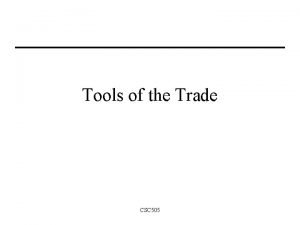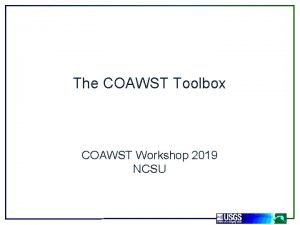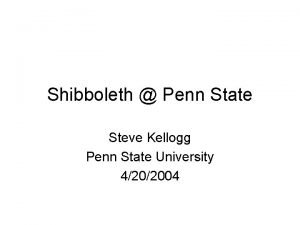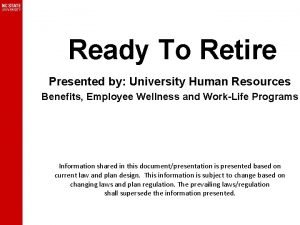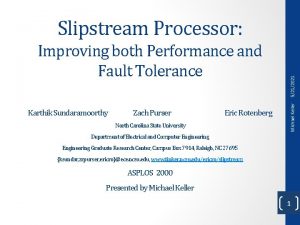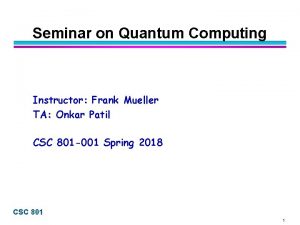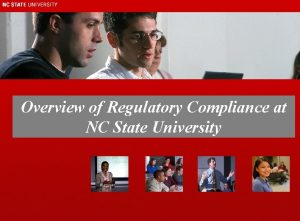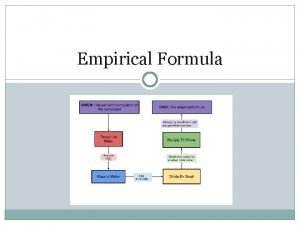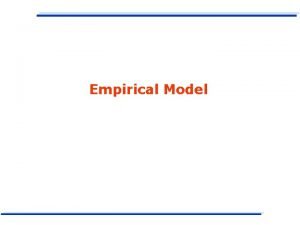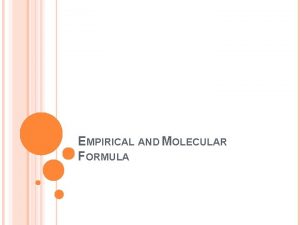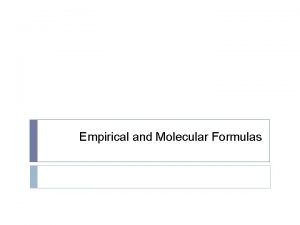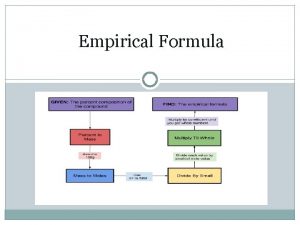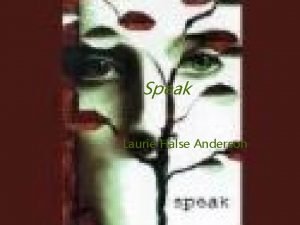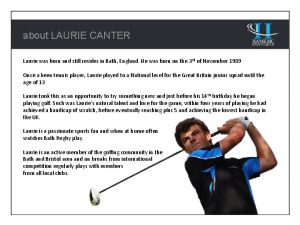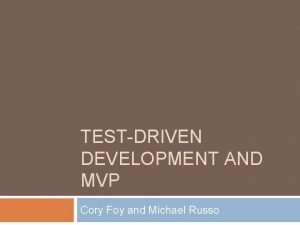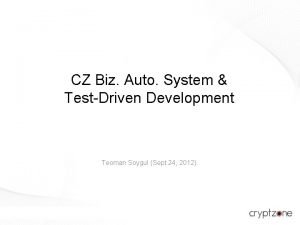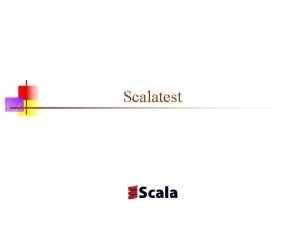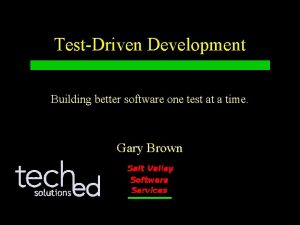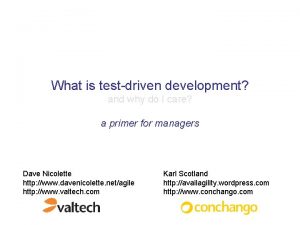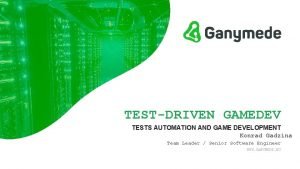Empirical Studies in TestDriven Development Laurie Williams NCSU






























- Slides: 30

Empirical Studies in Test-Driven Development Laurie Williams, NCSU williams@csc. ncsu. edu

Agenda • Overview of Test-Driven Development (TDD) • TDD Case Studies • TDD within XP Case Studies • Summary © Laurie Williams 2007

Test-driven Development © Laurie Williams 2007

Overview of TDD via JUnit © Laurie Williams 2007

x. Unit tools © Laurie Williams 2007

Agenda • Overview of Test-Driven Development (TDD) • TDD Case Studies • TDD within XP Case Studies • Summary © Laurie Williams 2007

Structured Experiment – 3 companies, 24 professional developers • all worked in pairs • Rolemodel, John Deere, Ericsson – Random groups: Test-first vs. test-last • Test-last “refused” to write automated JUnit tests test-never – Test-first: • 18% more manual, black box test cases passed • 16% more time • Good test coverage (98% Method, 92% Statement, 97% Branch) © Laurie Williams 2007

IBM Retail Device Drivers IBM research partners: Julio Sanchez (Mexico) and Michael Maximilien (Almaden) © Laurie Williams 2007

Building Test Assets © Laurie Williams 2007

Defect Density © Laurie Williams 2007

The New Anti-aging Formula? © Laurie Williams 2007

Lessons Learned 1. A passionate champion for the practice and tools is necessary. 2. JUnit well structured framework relative to “ad hoc” automated testing. 3. Can extend JUnit to handle necessary manual intervention. 4. Not all tests can be automated. 5. Create a good design using object-oriented principles. 6. Execute all tests prior to checking code into code base. 7. Write tests prior to code. 8. Institute a nightly build that includes running all the unit tests. 9. Create a test whenever a defect is detected internally or externally. © Laurie Williams 2007

Test-first Performance Research partners: Chihwei Ho; IBM: Mike Johnson and Michael Maximilien © Laurie Williams 2007

Sample Results © Laurie Williams 2007

Agenda • Overview of Test-Driven Development (TDD) • TDD Case Studies • TDD within XP Case Studies • Summary © Laurie Williams 2007

IBM: XP-Context Factors (XP-cf) • • Small team (7 -10) Co-located Web development (toolkit) Supplier and customer distributed (US and overseas) • Examined one release “old” (low XP) to the next “new” (more XP) © Laurie Williams 2007 16

IBM: XP-Adherence Metrics (XP-am) XP-am Metric Practice Old New Automated test class per user story Testing 0. 11 0. 45 Test coverage (statement) Testing 30% 46% Unit test runs person day Testing 14% 11% Test LOC/Source LOC Testing 0. 26 0. 42 Accept test execute Testing Manual Did customers run your acceptance tests? Testing No No Pairing Frequency Pair Programming <5% 48% Release Length Short Release 10 months 5 months Iteration Length Short Release Weekly © Laurie Williams 2007 17

IBM: XP-Outcome Measures (XP-om) XP Outcome Measures Old New Response to Customer Change (Ratio (user stories in + out) /total) NA 0. 23 Pre-release Quality (test defects/KLOEC of code) 1. 0 0. 50 Post-release Quality (released defects/KLOEC of code) 1. 0 0. 61 Productivity (stories / PM) Relative KLOEC / PM Putnam Product. Parameter 1. 0 1. 34 1. 70 1. 92 Customer Satisfaction NA High (qualitative) Morale (via survey) 1. 0 1. 11 © Laurie Williams 2007 18

Sabre-A: XP Context Factors (XP-cf) © Laurie Williams 2007 19

Sabre-A: XP-Adherence Metrics (XP-am) XP-am Metric Practice Old New Automated test class per new/changed class Testing 0. 036 0. 572 Test coverage (statement) Testing N/A 32. 9% Unit test runs person day Testing 0 1. 0 Test LOC/Source LOC Testing 0. 054 0. 296 Accept test execute Testing Manual Did customers run your acceptance tests? Testing No No Pairing Frequency Pair Programming <0% 50% Release Length Short Release 18 months 3. 5 months Iteration Length Short Release -- 10 days © Laurie Williams 2007 20

Sabre-A: XP-Outcome Measures (XP-om) XP Outcome Measures Old New Response to Customer Change NA (Ratio (user stories in + out) /total) N/A Pre-release Quality (test defects/KLOEC of code) 1. 0 0. 35 Post-release Quality (released defects/KLOEC of code) 1. 0 0. 70 Productivity (stories / PM) Relative KLOEC / PM Putnam Product. Parameter N/A 1. 0 N/A 1. 46 2. 89 Customer Satisfaction NA High (anecdotal) Morale (via survey) N/A 68. 1% © Laurie Williams 2007 21

Sabre-P: XP Context Factors (XP-cf) l l l Medium sized team (15) Co-located Large web application (1 M LOC) Customers domestic & overseas Examined 13 th release of the product; 20 months after starting XP © Laurie Williams 2007 22

Sabre-P: XP-Adherence Metrics (XP-am) XP-am Metric Practice New Automated test class per new/changed class Testing 0. 0225 Test coverage (statement) Testing 7. 7% Unit test runs person day Testing 0. 4 Test LOC/Source LOC Testing 0. 296 Pair programming 70% Release Length Short Release 3 months Iteration Length Short Release 10 days © Laurie Williams 2007 23

Sabre-P: XP-Outcome Measures (XP-om) XP Outcome Measures Bangalore SPIN Capers Jones Benchmarking group Pre-release defect density Similar Lower Total defect density Lower Productivity Similar Higher © Laurie Williams 2007 24

Tekelec: XP Context Factors (XP-cf) • Small team (4 -7; 2 during maintenance phase) • Geographically distributed – Contractors in Czech Republic for US development organization (Tekelec) • Simulator for a telecommunications signal transfer point system (train new customers) • Considerable amount of requirements volatility © Laurie Williams 2007 25

Tekelec: XP-Adherence Metrics (XP-am) XP-am Metric Practice New Automated test class per new/changed class Testing 1. 0 Test coverage (statement) Testing N/A Unit test runs person day Testing 1/day for all; 1/hour for quickset Test LOC/Source LOC Testing 0. 91 Pair programming 77. 5% Release Length Short Release 4 months Iteration Length Short Release 10 days © Laurie Williams 2007 26

Tekelec: XP-Outcome Measures (XP-om) Outcome measure F-15 project Pre-release Quality (test defects/KLOEC) N/A Post-release Quality (post-release defects/KLOEC) 1. 62 defects/KLOEC [Lower than industry standards] Customer Satisfaction (interview) Capability – Neutral Reliability – Satisfied Communication – Very Satisfied Productivity 1. 22 KLOEC/PM [Lower than industry standards] 2. 32 KLOEC/PM (including test code) [on par with industry standards] © Laurie Williams 2007 27

Empirical Studies of XP Teams © Laurie Williams 2007 28

Agenda • Overview of Test-Driven Development (TDD) • TDD Case Studies • TDD within XP Case Studies • Summary © Laurie Williams 2007

Summary • Increased quality with “no” long-run productivity impact • Valuable test assets created in the process • Indications: – Improved design – Anti-aging © Laurie Williams 2007
 Laurie williams ncsu
Laurie williams ncsu Laurie baker centre
Laurie baker centre Sam and verna williams
Sam and verna williams Andy williams robert williams
Andy williams robert williams Robbie williams janet williams
Robbie williams janet williams Paradigm shift from women studies to gender studies
Paradigm shift from women studies to gender studies Ncsu guest wifi
Ncsu guest wifi Ucopia edge
Ucopia edge 505 design
505 design Ncsu toolbox
Ncsu toolbox Irvings penn state
Irvings penn state Ncrgea dental plan
Ncrgea dental plan Eric rotenberg ncsu
Eric rotenberg ncsu Spencer muse ncsu
Spencer muse ncsu Glenda darrell ncsu
Glenda darrell ncsu Wolfprint ncsu
Wolfprint ncsu My pack portal
My pack portal Frank mueller ncsu
Frank mueller ncsu Ncsu webassign
Ncsu webassign Ncsu pdk
Ncsu pdk Gsl ncsu
Gsl ncsu Vpn slides
Vpn slides Healthypackportal
Healthypackportal Campus smiles ncsu
Campus smiles ncsu Ncsu iacuc
Ncsu iacuc In spanish translation
In spanish translation Ece 506 ncsu
Ece 506 ncsu Business entrepreneurship minor ncsu
Business entrepreneurship minor ncsu Csc ncsu
Csc ncsu Burnt mill creek wilmington nc
Burnt mill creek wilmington nc Ncsu stat
Ncsu stat








